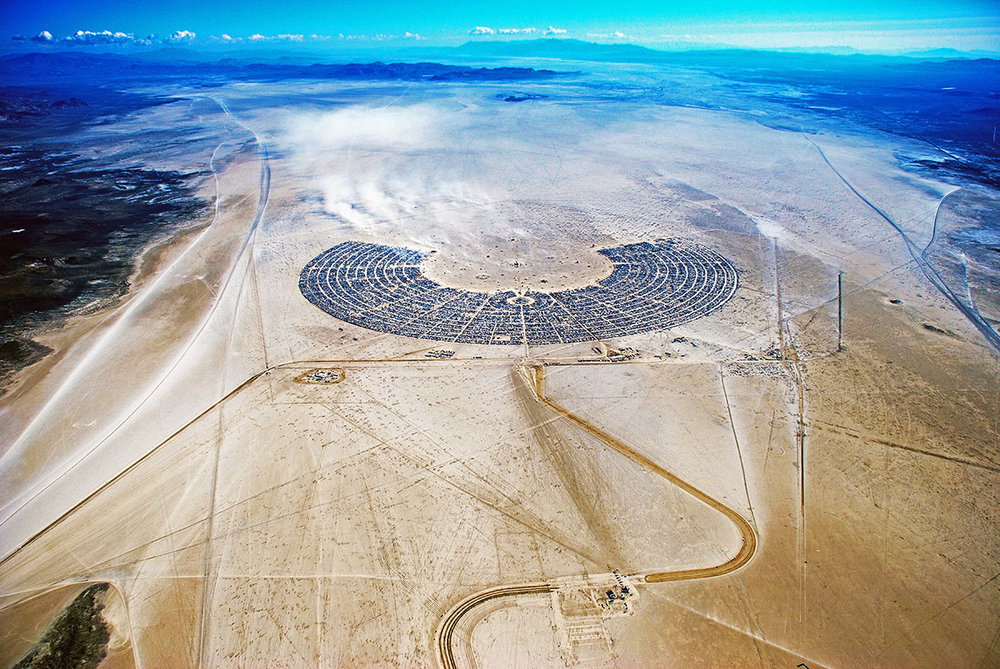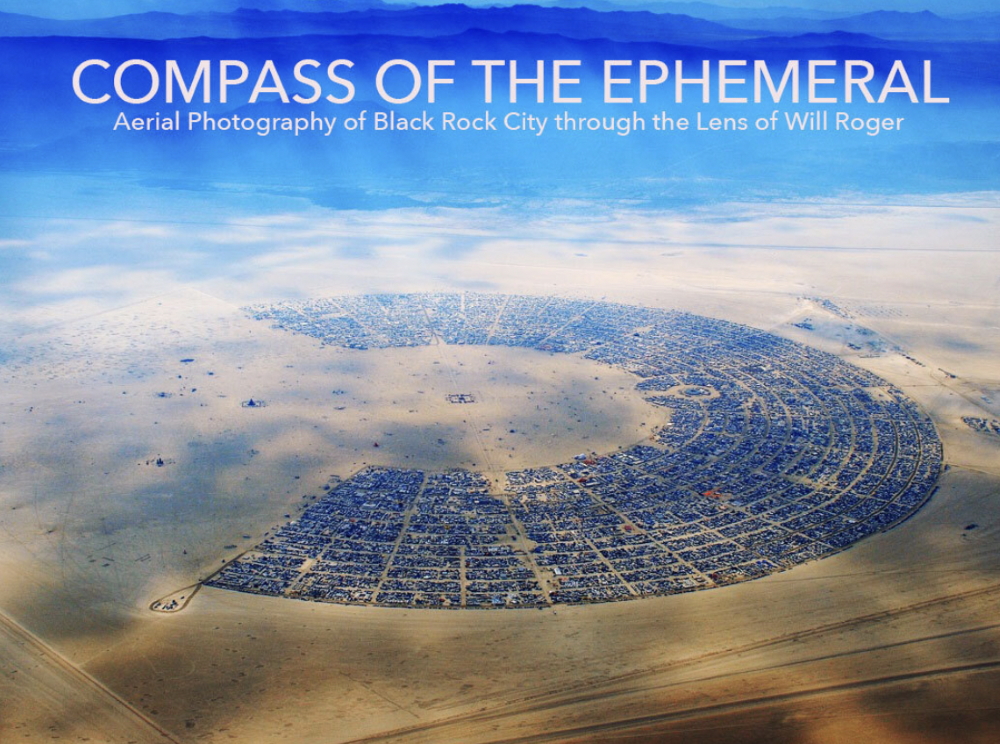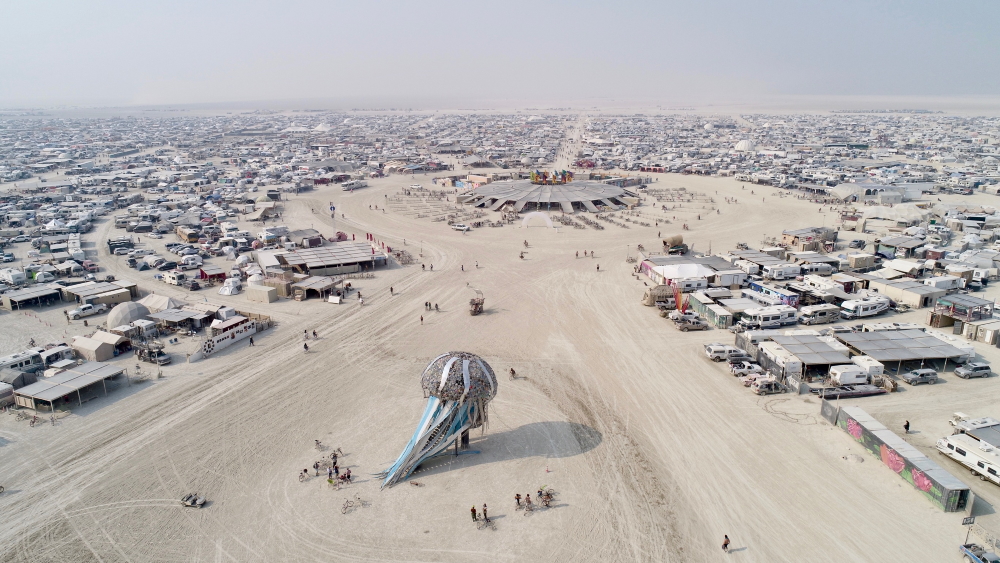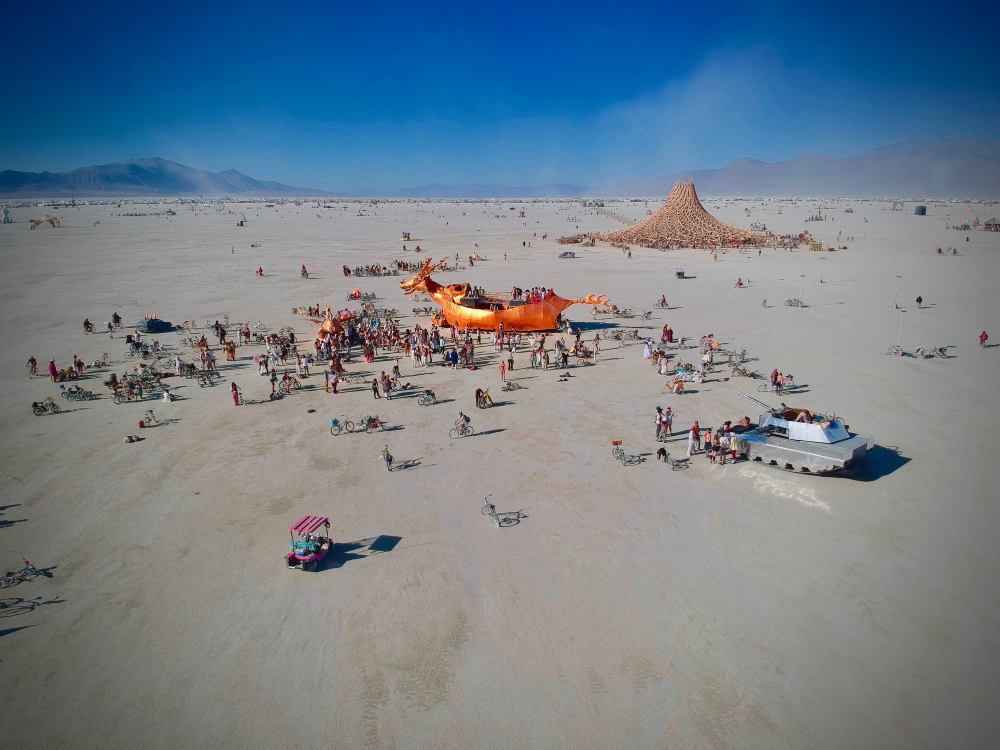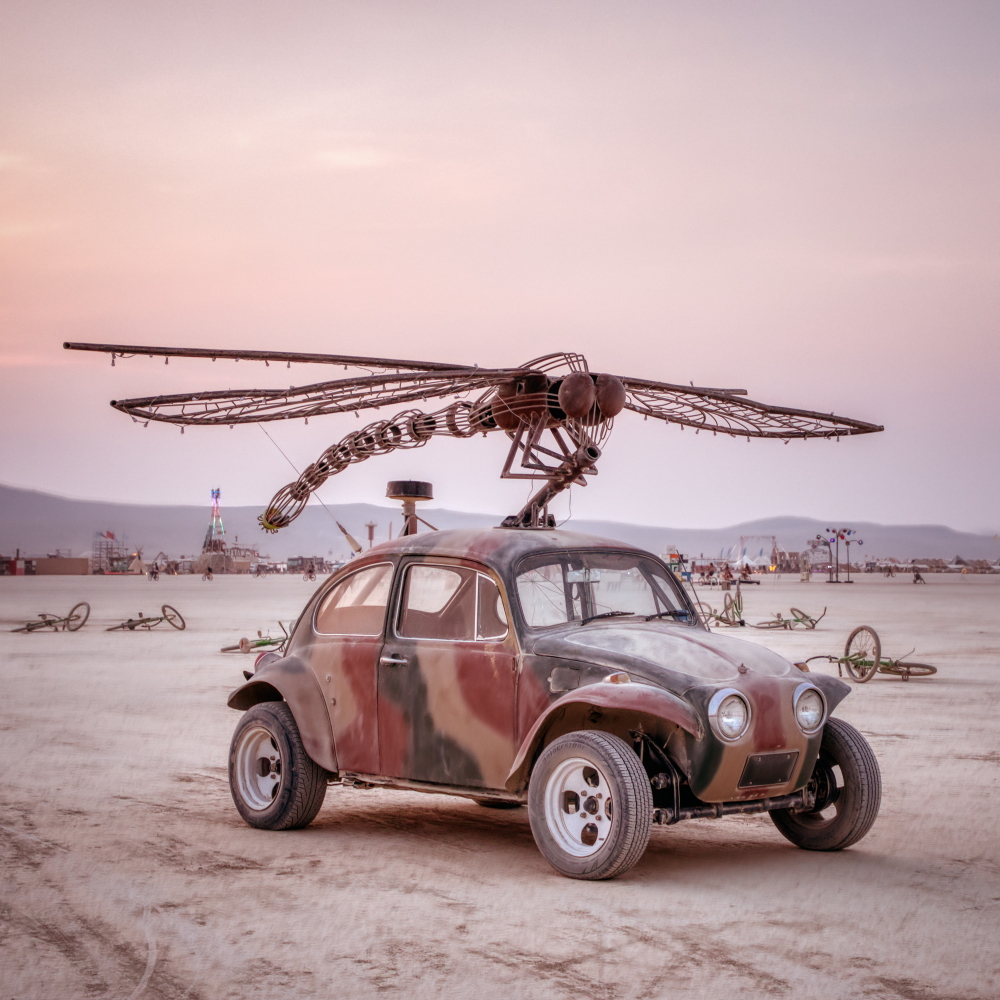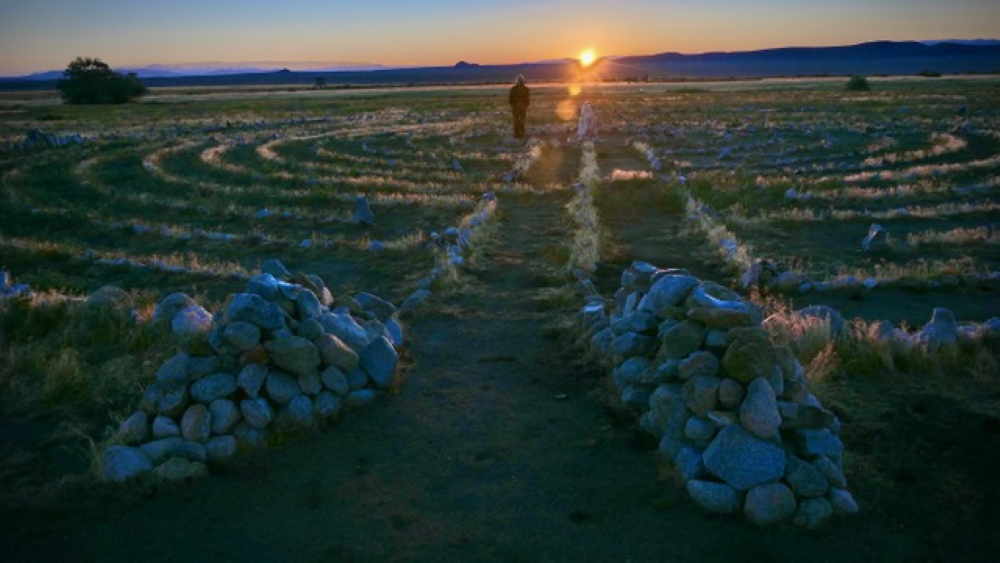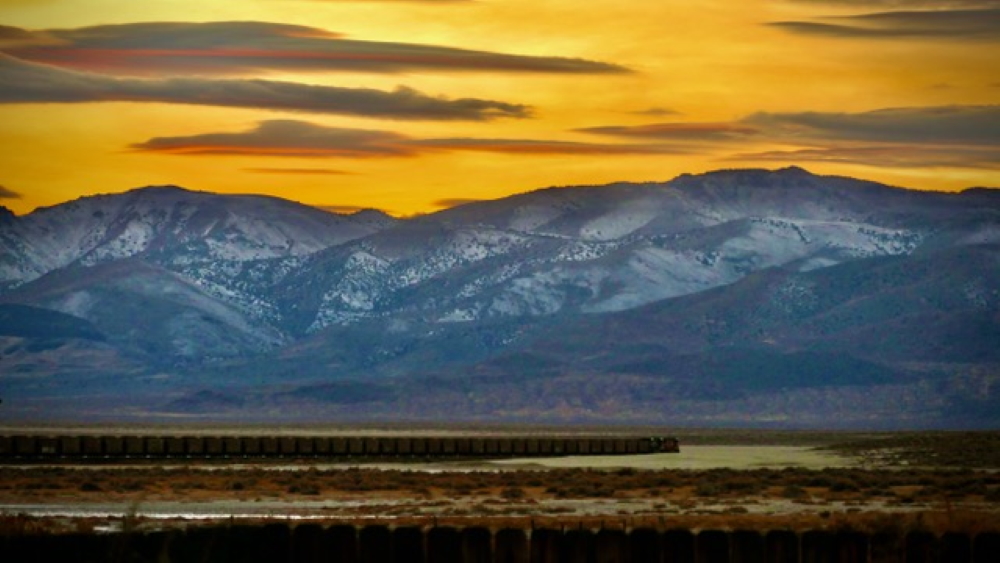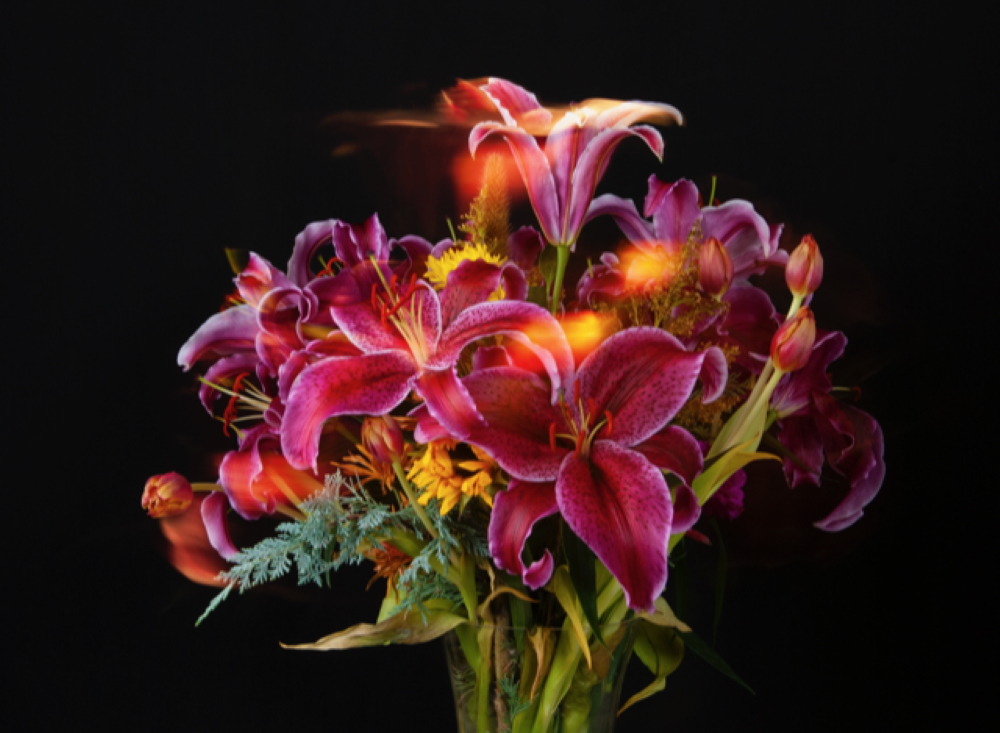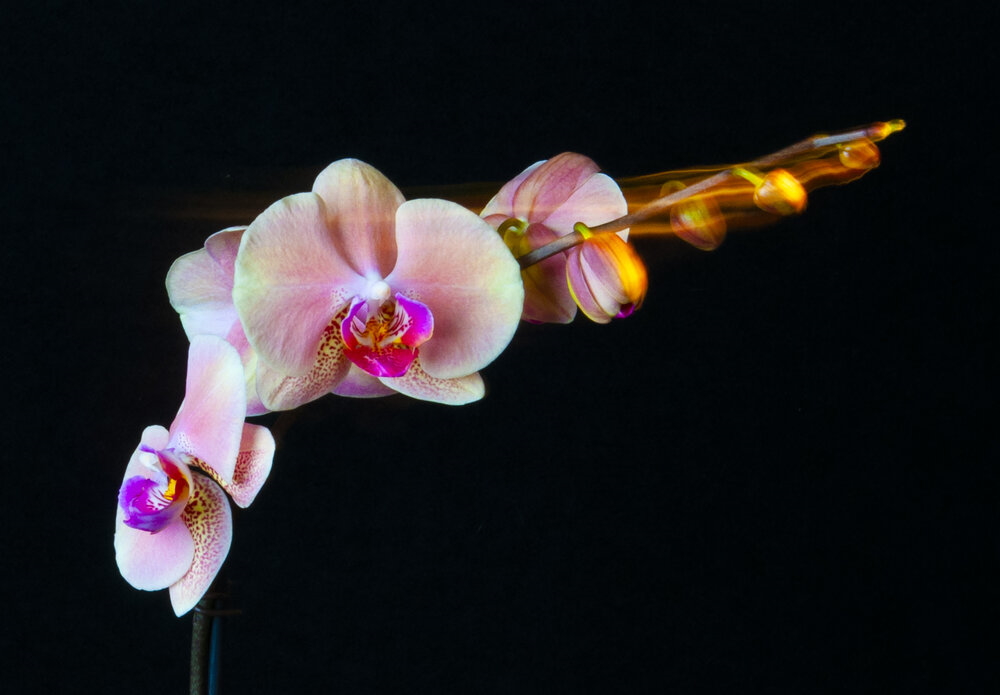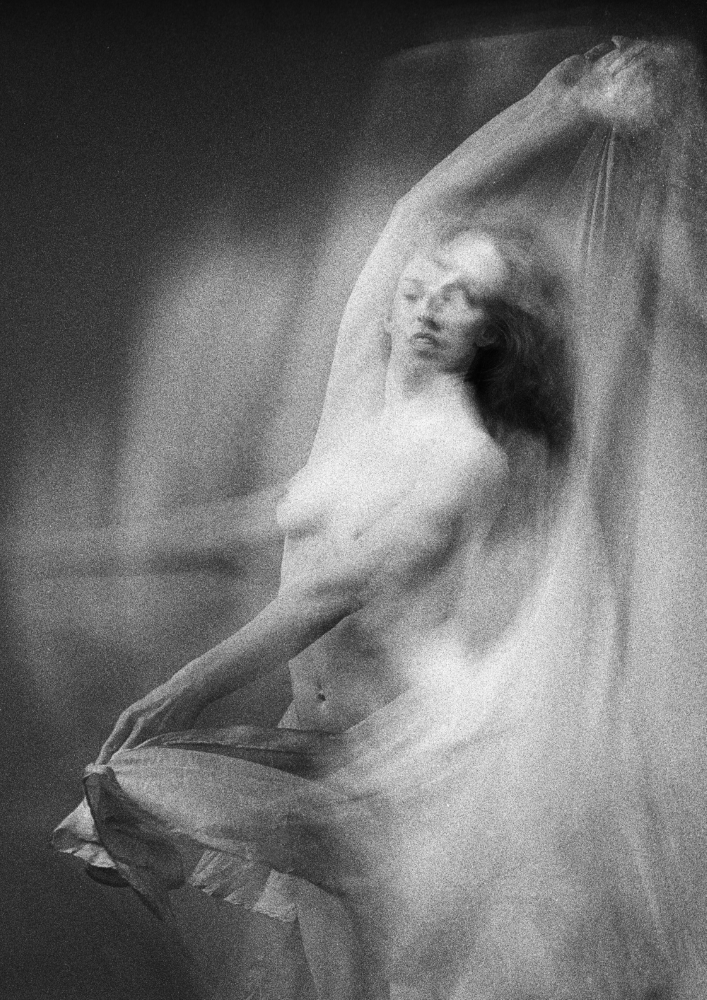Will Roger
Co-founder 'Burning Man' / photographer / writer/teacher / innovator / environmentalist
US
World-famous and legendary: Burning Man, the annual spectacle of art, music, and community – a playground for freedom-loving people to live their individuality and indulge their exuberant creativity in a free environment of like-minded people. The unique extravaganza with its yearly changing theme „draws tens of thousands of true believers to a barren landscape in Black Rock Desert/USA every August to create a temporary city full of monumental art installations and mind-expanding experiences“, is written on news.artnet.com. „The desert ritual“ (Wall Street Journal) culminates in the symbolic burning of a large wooden effigy referred to as The Man. Will Roger (Peterson) as a co-founder has been one of the key organizers for decades. This artist (photography), author, teacher, innovator and environmentalist is quoted on relix.com as follows: „The freedom to explore all art forms on such a massive scale is an incredible phenomenon and experience!“ To this remark was added depth by him on dezeen.com: „There’s a creative experience in Black Rock City. Even a non-artist will come to Burning Man and be stimulated to create things.“
Will Roger
Co-founder 'Burning Man' / photographer / writer/teacher / innovator / environmentalist
US

From 100 people at a bonfire on San Franciso’s Baker Beach in 1986 to 80.000 at Nevada’s Black Rock Desert in 2022! "Once considered an underground gathering for bohemians and free spirits of all stripes“, observed the American privately and state funded nonprofit National Public Radio, „Burning Man has since evolved into a destination for social media influencers, celebrities and the Silicon Valley elite." The global demand for this much publicised meeting of the spirits is greater than its limited capacity.
„Will Roger discovered Burning Man in 1994, through his wife Crimson Rose. Together and with several others, they co-founded Black Rock City, LLC, which has supervised the Burning Man event since 2000. Will (* 05/04/1948) founded and managed the Black Rock City Department of Public Works — a team of several hundred people responsible for the pre-event and post-event construction logistics and production“ (Wikipedia), because after the demolition of the increasingly complex infrastructure there has to be no trace of the large-scale event left.
It is a miracle in the high desert building a fully functional pop-up city with airport, hospitals and emergency camps plus all kinds of camps (thematic and interactive ones) - 170 miles north of Reno on the largest flat expanse in North America. Vending, money-exchange or advertisements are forbidden. The fascinations in this free space for free spirits are different from the otherwise „real“ world – and they are multifaceted. Crimson Rose has developed the Art Department for this one-of-a-kind-gathering featuring architectural installations, sculptures, performances and mutant vehicles like a yacht or massive shark on wheels. Thanks to her „guidance, Burning Man serves as an inspirational limitless canvas“ (dezeen.com).
On occasion of the publication of his book „Compass of the Ephemeral: Aerial Photography of Black Rock City through the Lens of Will Roger“ the author was interviewed by The Relix Channel. The dedicated social activist who had worked for nearly 20 years at the Rochester Institute of Technology/New York as a photo-chemist, administrator, associate professor, and Assistant Director said: „The key words are ‘Burning Man community’, as compared to what we call the ‘default culture’ — the culture we live in outside the event, where people often feel separated from each other. When at Burning Man, the ‘10 Principles’ (Radical Inclusion, Gifting, Decommodification, Radical Self-reliance, Radical Self-expression, Communal Effort, Civic Responsibility, Leaving No Trace, Participation, Immediacy) — [along with] unconditional love and overpowering creativity — are some of the things that make Black Rock City different from the default culture and powerful as a life changer. The culture of Burning Man provides an opportunity to celebrate the world and humanity in an authentic expressed form.”
Crimson Rose and Will Roger live in Gerlach, Nevada.
Interview December 2022
Connecting with nature: "earth energy is creation energy!"
INTUITION/IMAGINATION
How does intuition present itself to you – in form of a suspicious impression, a spontaneous visualisation or whatever - maybe in dreams?
We have a lot of inner voices, different voices that come up for us in our own thoughts, in our mind. Some of it we call just an inner voice, and that's a cultural thing. Some of it is critical thinking. So when you're focused on a problem and thinking very critically about it, your inner voice isn't involved. Then there's an ancient voice and one that I call the 'common consciousness'. Freud called it the 'collective unconscious'. I believe that we can bring that voice up by using triggers that are based on earth phenomena. For me, creation energy is earth energy because we live on a planet where everything that has evolved over 3 billion years of evolution has been created by the earth. The idea that creation energy and earth energy are connected is very strong for me. What I do every day to raise my level of intuition is connect myself to earth energy. And I do that by walking our labyrinth (NOTE: see photos on the right), looking at the sunset, the sunrise, the moon, the sound of running water, the rustling of the wind in the trees, and having contact with wild animals. Those are the things that bring up what you might call intuition, which I call the collective or the common consciousness. I've written a couple of books that talk about it. The second one is called Handbook for a Burning Age. So for me, intuition comes from my connection to nature in some way.
?: How do you come up with good or extraordinary ideas?
Good ideas and possibilities are always there for us. And yet, we're in a fog most of the time that doesn't allow us to see the opportunities and the possibilities that exist. Once in a while, we wake up and then an opportunity comes by and we take it and it's life changing, and we go change our lives. And all of that's cool, but really we’re in a creation flow where there's creative possibilities and inspiration there all the time. And I think the important thing to do to become an artist and to foster the art spirit that's within us, and we all have that, is to work on our clarity, and the who that we are, rather than the who that we think we are. The big point there is to remove our inner dialogue from the present moment. If we can do that, then the opportunities of creation flow in. And so that's what happens when you get into a flow, an artistic flow. Your inner voice doesn't interfere cuz you're not questioning it, you just let it happen.
I think we could be in that heightened state a lot more than we are. In fact, I believe that we could be in that heightened state all the time, and if we did that, it would change the way humans live on the planet. We would be in creation energy, and we would be happier and more powerful and more in tune with the reality that we're in on this planet in an infinite universe. So the idea of creation energy and this whole interview and everything that we're talking about is so vital and so important to the evolution to the next place that humans need to be in order to continue living on this planet! If we don't walk through this door of creation energy together as humanity, then Mother Nature is going to cause us to walk through that door painfully. So what I'm trying to do as an artist is wake people up before we get to the point that Mother Nature causes us to wake up. And we may already be past that point, I don’t know.
One of my affirmations that I use every night is that I am in the cosmic flow. And when you're in the cosmic flow, then creation energy is right. You're in it, it's like a soup. You're one of the ingredients and it's really kind of cool. That's why when I walk and I do my affirmations and I bring my camera with me, the creation energy then pops up for me and magic starts happening. I get birds coming over and rabbits hop by and a hawk will fly through, and all of that starts happening because I’ve dropped the cultural construct that doesn't allow magic to come in. So all of a sudden I allow the magic to come in, and then it starts happening all around me. I get that every night so I feel blessed.
Do you feel that new creative ideas come as a complete picture? Or do you get like a little seed of inspiration and then it evolves into something else?
Sometimes the whole big picture comes, and you see the goal and you don't really know how you're going to get there. But you see the goal and then you take one step forward towards the goal, and then the path is revealed, right? But you gotta take that step, you gotta take that chance. So there's chance in it. I like chance a lot, the idea of chance puts you in the state of magic. The flowers that I do, for example, it's a framework where there's a lot going on in the moment that I take that picture. I'm spinning the flowers, I got a flashlight, I'm firing the camera, I'm looking at it, and yet it's moving. And I don't really know what I'm doing, but I feel the inspiration of what I'm trying to do. And then later when I edit, that's when I see what magic happened.
So that framework is real important for me. I have a certain way that I shoot the flowers: it involves studio lighting, a flashlight, a turntable and a beautiful bouquet that often Crimson makes. And I have an idea of what I want. What I'm looking for is anamorphic images of faces and animals and stuff in the motion that I get from the painting with light. But I can't see that when I'm doing it. I can only try to imagine it a little bit. So there's that creation energy coming in. There’s a process of creation in the editing too. I walk away from the studio often feeling lighter. There's like an energy that's really kind of neat. There’s a spring in my step, which at my age I don't get very much anymore. But it's there and it feels really good. Once you find a process that works for you, you want to get back to it because there's magic in it.
INSPIRATION
How do you stimulate your source of inspiration?
The earth energy is creation energy. If you really look at where we come from as an evolved species on a planet, we're made up of materials from the planet. I mean, if you look at creation energy any other way, it's a story. It's not real, it's a story. As I've said: for me, creation energy is earth energy. So I try to find my inspiration working with the elements from the earth, which we all do, no matter what. Everything that you see scattered in this office behind me was made from stuff from the earth. For me, earth energy is everything. So I try to work with that. What I'm trying to do is to show people that there's magic all around us all the time. I hope my artwork achieves that, at least for some people. Some people aren't ready to actually see that. You have to get there on your own, but there's magic. The fact that we're on this rock flying through an infinite universe, and that this rock happened to have the right materials to create life. That life started with a single cell, and it evolved into millions of species of different plants and birds, reptiles and mammals, and we're all part of that. There's a magic and a creation and a mystery to all of that. There always will be no matter how far we dig in with science, the next question. And so there's a magic in the mystery of being who we are on this planet. That's what I try to approach as an artist. If I can get people to see that a little bit, and to find who they are in it, then we maybe have a chance to save the planet and save our habitat. So everything I do is around trying to wake people up. As an artist, I feel it's my obligation to wake people up.
How do you filter between ideas that are worth sort of pursuing and bad ideas or ideas that you just let go of?
Sometimes your bad ideas at first are your best ideas. You know, I don't really discriminate much. I try to work within things at this point in my life that I know that I can achieve. There's a lot of things I can't do anymore, so I can't really use them as ideas. They're nice dreams, but they're not something I can manifest. So what I try to do is work with the things that I can manifest. And as you grow older every day, you have less of those. So it's interesting. What I'm doing is sort of narrowing my focus on what is possible in many ways. That is that framework that creates this thing that's much bigger than maybe the possibilities that are not doable. Within the frame, my shrinking frame, I find an infinite level of possibilities.
CREATIVITY
Which time or place or environment suits your creative work process the best?
Well, I'm a trained studio artist. That's where my background is. So I walk into my little studio in Gerlach/Nevada and I can feel the creation energy there because I've worked in that place a lot, and it feels comfortable. Some of it is your intention. When I walk into the studio, I have the intention to create, there's creation energy there. For me, the place itself is a marker for bringing up that creation energy. The other place is anywhere outside. As soon as you go outside, you're under the influence of the planetary cycles, right? You walk outside and there's a moon and a sun, and all of a sudden there's a dynamic and a connection that has been repeated by humans for two million years.
So when you're outside, and especially when you're outside in the wilderness somewhere - my back fence borders the wilderness here - and the wilderness comes in fact over the fence and it's on our property. So I feel good about that. I feel like when I'm doing my walks, we have a labyrinth that we walk out at the Fly Ranch. That's a very special place because the horizon you can see is visible to the East, and you have mountains to the West. It's a magnificent valley in Nevada. You can feel the creation energy there. You feel the connection to the earth and to the moon and the stars and all of that, especially at night. Those are the places that I think cause me to connect to the earth energy, to the creation energy.
Everywhere we are, we're in nature. I mean, nature is everything. I don't take pictures around the house much because that's where I live, but when I'm in the house and I walk into the studio, a shift happens. Something happens. It has to do with an intention, an artistic intention. When I walk outside, it's not always to commune with nature. I might be out gardening or washing my car or truck or something, that's a different mindset. It's your intention. Every day 20 minutes before sunset, I start my labyrinth walk. My intention, I bring that with me. So I create the framework that allows me to interact with nature as an artist. When I walk out the door to the studio and go to the labyrinth, my intention is different than when I walk out to wash my truck. Now, that doesn't mean that, if I have my phone with me and I see a red-tailed hawk sitting on the post next to my truck, that I won’t take a picture of the hawk. In that moment I'm an artist and something might happen. The hawk might spread its wings perfectly or a raven might dive bomb. This crazy interaction happens. Then I have the opportunity to create a connection to that. That's the artistic connection and is always there. It might not have been my intention in that moment, but if I'm open to the opportunity then I bring that artistic intention even to washing my truck.
What is better in the realization process: speed and force creativity i.e. grasping the magic of the moment, or a slow, ripening process for implementation or elaboration?
Oh, they're both really important. I think as a photographer, the first one's really important: the moment. The idea of 'The Decisive Moment' goes back to a French photographer named Henri Cartier-Bresson. He shot incredible images that had to do with seeing things in the moment. As a photographer, you're very much involved with the creativity of the moment and the spontaneity of that. As a writer, I think there's a long slow burn that happens. Although the initial inspiration might be like a real momentary thing. You write it down, might put it in your notes and then not do anything, but you had a flash. That flash got recorded. Then you may go back to that flash even years later, and a whole book can come from that one sentence that you wrote, right?
So that’s a long slow burn. You might have had an inspiration that you couldn't take action on. For many reasons you might not have been able to. You might not have your thoughts, they might not have been mature enough at the moment, but the idea came. And so later on you evolved, go back to that idea that has slowly been working through your consciousness, and eventually you come up with a way to work with it, describe it and so on. You might write a paragraph, a chapter or a book, based on what that idea was.
I'm not a musician, but I think a musician might have a different way of responding to that question too. You might get a melody and it's a flash. Then it's in your brain and your creative juices flow with that melody, change and alter it. Then different instruments come in and all that. For a sculptor it would be like, you have the idea and then spend maybe a year making it into a masterpiece. So I think different art forms maybe respond to that question differently.
Do you have any specific strategies you use when you are feeling stuck creatively?
Yeah, I wish I did. No, I get stuck really bad, especially writing. Oh my goodness, I go through months where I can't write. I don't even want to look at Emails. It’s funny, then something will happen and I'll sit down and write for two weeks. That's the nature of my writing. Other people write differently. There's something about daily practice that's really important. The dominant cycle for humans and everything on the planet is the revolution of the earth. So sunset, sunrise, we have light, we have darkness, that's daily. That happens every day of our lives. And we take it for granted. We don't even really think about it. But the daily cycle is the most important cycle. It runs our bodily functions. It runs a lot of different things.
If you as an artist put in something in your life that's a ritual that happens daily, then you've achieved a lot. As an artist, I think you're on the right track. So for me, daily practice is going for a walk at sunset every night. I haven't missed that in, I don't know, probably ten years. It’s more important than anything else. I don't schedule anything. You try to schedule something at sunset with me, and you're going to get a big 'NO!". I don't do it. I don't go to dinner functions with other people. I don't socialize. I don't have a drink. I don't do anything else but walk the labyrinth at sunset. If I don't have my labyrinth, if I'm somewhere else, I just go for a walk. That has created a framework for me of creativity. It's powerful. Again, earth energy is creation energy.
As an artist, you need to recognize that you need to connect it to the earth. That happens with daily practice. If you’re a writer, write every day, even if it's just a sentence, but write every day. If you're a musician, you should practice every day. As human beings, we need to practice being human every day. We don't even do that. We're in a fog, we're in a dream most of the time. It's a cultural dream. It's the dream that our culture wants us to be in, to be consumers. To deal with creation energy outside of the dream that's being imposed on us creates clarity. It creates vision. It creates an opportunity for intuition and creation energy to enter. We need to do that in order to wake up, be real and understand where we are as humans - as artists and as people on a planet that's sort of out of control right now.
I try to practice daily, and I think that is very, very important for everyone. I mean, what do you practice daily? I have my coffee every morning, I put my socks on. Well, that's good. You know, some days you might not wear a sock, but I mean, if you look at your life that way, as rituals, I think you'll have a better understanding of who you are on this planet, and who's creating the real ritual, which is sunrise and sunset, moon rise and all of that. We tend to ignore the truth because we're sort of brainwashed by a culture that wants us in a dream.
The way I've learned to look at things as I've grown older is actually, things have gotten simpler in many ways. I see humanity’s place on the planet differently than I did when I was in my forties or fifties. I'm finally able to talk about it. I did a two-series podcast on 'the art of dynamic competence'. I do talk about creation energy and stuff like that in that, so you might find some gems in there.
Is it better to be creative on your own and only trust your own instincts or to work in a team?
A lot of my work is alone. The solo artist has always been an important contributor to our culture. On the other hand, the idea of collective art and collective consciousness, working towards a common goal with a group is phenomenal. There’s nothing quite like it because everyone gets buoyed. Their spirit rises because of everyone. It’s the best use of the term synergy; the collective result is much greater than the individual parts. So you have a synergy that happens with the group, with group art. The interesting thing is: there's the art, the inspiration of the art, and then there's the making of the art. The making of the art isn't quite as high of an art form as the inspiration part, right?
I could be working on a big sculpture at Burning Man, being part of the art spirit and the art, but I'm a carpenter. I'm a framer, and I'm just framing it up. It's different than I think what we might call a high art, where an inspiration happens, it's somehow created and resolved by the individual who had that idea. I'm thinking of Bach writing the 'The Brandenburg concertos'. He did that on his own. He didn't have workers working with him, that wasn't collective. Then I'm thinking of a big piece of art, like the pavilion that the Man stands on at Burning Man. That’s a beautiful artistic piece, often designed by a single artist or maybe a group of several artists. Then it's collectively built by two or 300 people, right? They're all part of that art spirit, but on a different level. At that point the people that were inspired to create the direction that art is going in need to make sure that that art spirit is received by all the people that work on it. Then that collective thing happens, and the synergy happens. (Sculptor) David Best is a good example. He (wo has built various temples at Burning Man between 2000 and 2014) has a way to inspire everyone that has anything to do with the art that he's creating. David Best brings that inspiration to them. That creates a collective consciousness and this incredible flow that happens. Things might look impossible to meet the deadlines, then all of a sudden the flow is activated and things get done early. It’s just remarkable to see the machine that happens when you have a collective consciousness like that. But there must be, I believe, an inspiration that's handed down by the people who have been hit with the original creative spirit of whatever it is they're doing. I use David Best as an example, but I think we could pull many, many examples of that happening in the Burning Man community.
(Burning Man co-founders) Larry Harvey (died in 2018) burned a thing on a beach with Jerry James. There was a creative moment. Everybody saw it. The rest of the beach just ran down to see ‘The Man’ burn. Larry had an incredible way of enlisting everyone in his creative ideas. I mean, we're a result of that. We're all a result of that, because he was inspired every day, every moment. The guy was a walking creation machine. He was great. And I miss him terribly, but I also feel that he is with me because he taught me in many ways how to take risks in being an artist. I could never thank him enough. I miss him because of the parody, the craziness and the art spirit that would happen. I'm working to create that same thing in my own life, inspiring other people in a much different way – by getting people to wake up, take risks, take chances, be real and be who they really are. Those are the things that are important right now. I'm involved with that, and it feels good.
You go to Burning Man and you’re like 'Whoa, I can get engaged with all different kinds of art on all different levels or make my own or whatever'. The art spirit is there and it's a powerful spirit. It's the spirit that our dominant culture lacks. We don't have that. We're taught to think that art is a kind of a substandard thing in our lives, and that we need to find our happiness with buying something and all of that. It's kind of a funny place, but at least for a week in a desert in the summer, we can go to Burning Man and feel humanity in a different way. We can be engaged with creation energy and the power of the earth and all of that. So I'm very grateful that I've had a lifetime of supporting this community, helping it grow and watching it mature. It's been great.
When does the time come to end the creative process, to be content with what you've created? Is there a final result, or is it sort of always a work in progress with endless possibility of improvement?
It depends on the art form that you're involved. With photography, it's ended after you processed it and you put it out there publicly. That's what I do every night. Every day I take about 70 pictures at sunset, I edit it down to 20. I process them, I put them up on Facebook, and then I'm done. I'm probably not going to look at them again until somebody asks me because they need a picture of a sunset. Then I go back in and look for one. That might be appropriate. But for me, photography's cool that way because it's cut, dried and it's done. Writing, oh my goodness. It's funny, I’ll tell you a story. I wrote a book called In Search of the Common Shaman. It's an autobiography, but I'm still alive, so that means that the last chapter still hasn't been written. I'm still writing it.
My publisher at the time wanted to put a book out so he designed another book, and then that came out, and that's done. I don't even look at that book anymore. Then they wanted to do another one, but he didn't want to publish any more. So I self-published my second book, which is kind of a synopsis of the first book that isn't published yet. So the first book, which is a real creation piece for me, still is not done. It's right here on this monitor next to me, because I promised my agent that I would have it done this winter. And every time I go into it, I want to change everything. Because what happens when you're writing something that's a biography or a history or an autobiography, as you change, as you mature, and we do that daily, your view of what you thought you wrote correctly years ago, your view of it changes. So then you want to rewrite that because you're in a different place now, you see the world differently, and you see your history differently. So I'm having trouble trying to finish the third book. It’s not done yet because my view of what I wrote years ago has changed. So my answer to that question is: sometimes you can never find that place where it ends, and sometimes it ends the moment that you created it.
What's your concern as an artist?
I like to create frameworks. Ideas will come based on how I'm reacting to that framework.
I was once a professor of photography at a pretty good Eastern school. In my teaching, I learned very quickly with my students, that if I gave them an assignment and it didn't have a framework, they wouldn't do good work. But if I gave them a really strict framework, then they would do great work because they had something to sort of bounce off of, right? It's that bouncing off of the framework that creates inspiration and ideas and so on. As a writer, I'm the same way. I'll have an idea. I start writing about it, and then all of a sudden I’m in the flow. As an artist, you get familiar with the idea of being absorbed by the work, and it's running through you. So you're inner voice changes your approach to it. Time stops. I've sat down at the computer as a writer and all of a sudden it flows It's ten hours later and it seemed like five minutes.
When you get into that flow as an artist, you're in the creation moment. I don't call it intuition, I just don't like that term. I call it many other things. It's creation energy for me. It comes from the earth. I've sort of dedicated myself to communing with the Earth every day at sunset. I do it as a human. I walk. It's something that humans do. Out of that comes a stillness and a connection that's quite powerful for me. Then my creation energy comes. I bring a camera along with me, I'll stop and take pictures of things that I find aesthetically pleasing or profound or maybe it's an idea about earth energy or the cosmos or whatever. And every day I post those. I've been doing this for many, many years now and it hasn't run its course yet. I keep doing it because every day there's a little bit of inspiration that drives me forward.
MY FAVORITE WORK:
Handbook for a Burning Age right now is the most important thing that I've done because it involves my photography, which is artwork. It's photography of nature and labyrinth and sunsets and things like that. It also involves my writing about how important the art spirit is in making this next step as humanity towards saving our habitat. That's the most important piece for me, and it's done. It's good. I can't change it. It’s a completed piece of work, and it involves two different things that are important to me: writing and photography. It also brings in another person who collaborated with me on the book who sees the world in a similar way, from an entirely different history. We came to the same place. It's kind of interesting. So I'm sort of proud to have completed that and have it out there. So that maybe is the most important piece that I've done.

